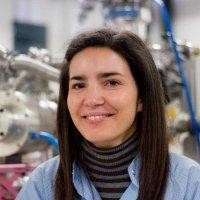Tracking electron dynamics induced by XUV attosecond pulses in molecules.

Event details
| Date | 17.12.2015 |
| Hour | 16:30 › 17:30 |
| Speaker |
Dr. Francesca Calegari National Research Council of Italy CNR-IFN Physics Dept., Politecnico di Milano |
| Location | |
| Category | Conferences - Seminars |
Dynamical processes in molecules occur on an ultrafast temporal scale, ranging from picoseconds (1ps=10-12 s) to femtoseconds (1fs =10-15 s) when concerning with a structural change, down to attoseconds (1as = 10-18 s) when dealing with electrons. Electron dynamics plays a very important role in bond-formation and bond-breakage, thus determining the final chemical reactivity of the molecule. Recently, theoretical studies have pointed out that after sudden ionization of a large molecule very efficient “charge migration” can occur along the molecular backbone on a temporal scale ranging from few femtoseconds down to tens of attoseconds [1].
In this talk I will first show that XUV attosecond pulses in combination with NIR/VIS few-cycle pulses can be used to investigate with extreme time-resolution the dissociative ionization dynamics of molecular nitrogen. The time-dependent measurements reveal the presence of NIR/VIS-induced transitions between N2+ ionic states together with an interference pattern that carries the signature of the potential energy curves activated by the XUV pulse. We show that the sub-fs characterization of the interference pattern is essential for a semi-quantitative determination of the repulsive part of these curves.
I will then show that the same time-resolved measurement can be exploited to investigate charge migration in more complex molecules such as aromatic amino acids. By measuring the time evolution of the yield of the doubly charged immonium ion for phenylalanine and tryptophan we were able to identify the presence of fast modulations of the dication yield with periodicities of 4.3 fs for phenylalanine and 3.9 fs for tryptophan. This fast dynamics can only be assigned to a pure electron dynamics, since nuclear dynamics usually comes into play on a longer temporal scale [2].
Finally, the same experimental approach allowed us to measure in real-time hydrogen migration occurring in 5-halo-uracils such as 5FU and 5BrU. In the case of 5FU, the XUV pulse ionizes the molecule catalyzing the hydrogen migration from C6 to C5 at the first step of the reaction, leading to the fragment m/z=44. The pump-probe measurement reveals that at early times, the NIR-VIS pulse inhibits the hydrogen migration process thus resulting in a sudden reduction of fragments m/z=44, and a consequent increase of fragment m/z=43. The rising (decaying) dynamics associated to fragment m/z=44 (m/z=43) occurs with a time constant of about 35 fs which can be associated to the time required by the hydrogen atom to migrate from the C6 site to the C5 site of the molecule. Similar behaviors were observed for the equivalent 5BrU fragments.
[1] L. S. Cederbaum et al Chem. Phys. Lett. 307, 205 (1999)
[2] F. Calegari et al., Science 346, 336 (2014)
In this talk I will first show that XUV attosecond pulses in combination with NIR/VIS few-cycle pulses can be used to investigate with extreme time-resolution the dissociative ionization dynamics of molecular nitrogen. The time-dependent measurements reveal the presence of NIR/VIS-induced transitions between N2+ ionic states together with an interference pattern that carries the signature of the potential energy curves activated by the XUV pulse. We show that the sub-fs characterization of the interference pattern is essential for a semi-quantitative determination of the repulsive part of these curves.
I will then show that the same time-resolved measurement can be exploited to investigate charge migration in more complex molecules such as aromatic amino acids. By measuring the time evolution of the yield of the doubly charged immonium ion for phenylalanine and tryptophan we were able to identify the presence of fast modulations of the dication yield with periodicities of 4.3 fs for phenylalanine and 3.9 fs for tryptophan. This fast dynamics can only be assigned to a pure electron dynamics, since nuclear dynamics usually comes into play on a longer temporal scale [2].
Finally, the same experimental approach allowed us to measure in real-time hydrogen migration occurring in 5-halo-uracils such as 5FU and 5BrU. In the case of 5FU, the XUV pulse ionizes the molecule catalyzing the hydrogen migration from C6 to C5 at the first step of the reaction, leading to the fragment m/z=44. The pump-probe measurement reveals that at early times, the NIR-VIS pulse inhibits the hydrogen migration process thus resulting in a sudden reduction of fragments m/z=44, and a consequent increase of fragment m/z=43. The rising (decaying) dynamics associated to fragment m/z=44 (m/z=43) occurs with a time constant of about 35 fs which can be associated to the time required by the hydrogen atom to migrate from the C6 site to the C5 site of the molecule. Similar behaviors were observed for the equivalent 5BrU fragments.
[1] L. S. Cederbaum et al Chem. Phys. Lett. 307, 205 (1999)
[2] F. Calegari et al., Science 346, 336 (2014)
Practical information
- General public
- Free
Organizer
- ISIC Physical Chemistry Seminars
Contact
- Dr Frank van Mourik